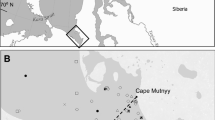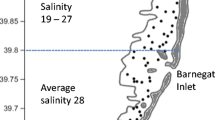Abstract
The effects of reservoir aging on the benthic macroinvertebrate community in Pawnee Reservoir were documented by comparing species composition and biomass of samples collected from October 1991 through September 1992, to a similar survey conducted in 1968–70 by Hergenrader & Lessig (1980). Filling of the basin with sediment and associated material and the subsequent change in the benthic environment, has resulted in a relatively homogenous bottom substrate at each of the three sampling transects (dam, middle, and inflow). Sediment enrichment has limited the benthic fauna to species tolerant of brief periods of bottom anoxia and increased levels of organic matter, which has resulted in the disappearance of many taxa and a decrease in the abundance of remaining invertebrates. Significant differences in total biomass were found at each transect, as well as for the whole lake, between study periods. The dam, middle, inflow and total biomasses for the 1968–70 study period were 2.4, 1.5, 2.3 and 2.0 g m−2, respectively, compared to 0.2, 0.2, 0.3, and 0.2 g m−2 for the 1991–92 study period. The total disappearance of eight invertebrate taxa, in particular two sphaerid clam species, and significant declines in other dominant taxa such as Chaoborus punctipennis and Chironomus sp. accounted for these major differences in biomass between study periods. Reductions in the number of taxa present has resulted in an increase in benthic faunal similarity at each transect, with tubificid oligochaetes, Coelotanypus sp., C. punctipennis, and Chironomus sp., comprising 90% of both the total density and biomass of benthic invertebrates in Pawnee Reservoir.
Similar content being viewed by others
References
American Public Health Association, 1989. Standard methods of the examination of water and wastewater. 17th edn., Washington D. C. 1391 pp.
Avnimelech, Y., 1989. Modelling the accumulation of organic matter in the sediment of a newly constructed reservoir. Wat. Res. 23: 1327–1329.
Baranov, I.V., 1961. Biohydrochemical classification of reservoirs in the European U.S.S.R. In P.V. Tyurin (ed.), The storage lakes of the U. S. S. R. and their importance for fishery. Israel Program for Scientific Translations, Tel Aviv, Israel: 139–183.
Bass, D., 1992. Colonization and succession of benthic macroinvertebrates in Arcadia Lake, a South-Central USA reservoir. Hydrobiologia 242: 123–131.
Benson, N. G., 1982. Some observations on the ecology and fish management of reservoirs in the United States. Can. Wat. Res. J. 7: 2–25.
Bordovshiy, O. K., 1965. Accumulation of organic matter in bottom sediments. Mar. Geol. 3: 33–82.
Brinkhurst, R. O., A. L. Hamilton & H. B. Herrington, 1968. Components of the bottom fauna of the St. Lawrence, Great Lakes. Great Lakes Institute. No. PR33, 49 pp.
Brinkhurst, R. O., 1969. Changes in the benthos of Lakes Erie and Ontario. In, Proceedings of the conference on changes in the biota of Lakes Erie and Ontario, Bull. Buffalo Soc. Natur. Sci., 25: 45–71.
Burris, W. E., 1954. The bottom fauna development of a newly constructed pond in central Oklahoma. Proc. Okla. Acad. Sci. 33: 129–136.
Dendy, F. E., W. A. Champion & R. B. Wilson, 1973. Reservoir sedimentation surveys in the United States. In W. C. Ackermann, G. F. White & E. B. Worthington (eds), Man-made lakes: Their problems and environmental effects. Geophysical Monograph 7, American Geophysical Union, Washington D. C.
Department of Environmental Quality (DEQ), State of Nebraska, 1993. Lake water quality assessment. Final Report, Lincoln NE.
EA Engineering, Science & Technology, Inc., 1991. Clean Lakes Program, Phase I diagnostic/feasibility study, Pawnee Lake, Lancaster County, Nebraska. Draft Report, Lincoln, NE.
Gloss, S. P., L. M. Mayer, & D. E. Kidd, 1980. Advective control of nutrient dynamics in the epilimnion of a large reservoir. Limnol. Oceanogr. 25: 219–228.
Golterman, H. L. & R. S. Clymo, 1969. Methods for chemical analysis of fresh water. IBP Handbook 8: 114–119. Blackwell Scientific Publications, Oxford, 172 pp.
Grimas, U., 1969. The bottom fauna of Lake Vättem, central Sweden, and some effects of eutrophication. Inst. Freshwat. Res. Drottningholm 49: 62.
Gunnison, D., R. M. Engler, & W. H. Patrick, Jr, 1985. Chemistry and biology of newly flooded soils: Relationship to reservoir water quality. In O. Gunnison (ed.), Microbial processes in reservoirs. Dr W. Junk Publishers, Dortrecht: 39–57.
Henderson-Sellers, B. H. & H. R. Maryland, 1987. Decaying lakes: The origins and control of cultural eutrophication. John Wiley & Sons, New York, 254 pp.
Hergenrader, G. L., 1980a. Eutrophication of the Salt Valley Reservoirs, 1968–1973. I. The effects of eutrophication on standing crop and composition of phytoplankton. Hydrobiologia 71: 61–82.
Hergenrader, G. L., 1980b. Eutrophication of the Salt Valley Reservoirs, 1968–1973. II. Changes in physical and chemical parameters of eutrophication. Hydrobiologia 74: 225–240.
Hergenrader, G. L. & D. C. Lessig, 1980. Eutrophicatiion of the Salt Valley Reservoirs, 1968–1973. III. The macroinvertebrate community: Its development, composition and change in response to eutrophication. Hydrobiologia 75: 7–25.
Hilsenhoff, W. L., 1967. Ecology and population dynamics of Chironomus plumosus (Diptera: Chironomidae) in Lake Winnebago, Wisconsin. Ann. Entomol. Soc. Amer. 60: 1 183–194.
Jónasson, P. M., 1984. Oxygen demand and long term changes of profundal zoobenthos. Hydrobiologia 115: 121–126.
Kajak, Z., G. Bretschko, F. Schiemer & Ch. Leveque, 1980. Zoobenthos. In E. D. LeCren & R. H. Lowe-McConnell (eds), The functioning of freshwater ecosystems, IBP 22, Cambridge Univ. Press: 285–307.
Kajak, Z., 1988. Considerations on benthos abundance in freshwaters, its factors and mechanisms. Int. Revue ges. Hydrobiol. 73: 5–19.
Kimmel, B. L. & A. W. Groeger, 1986. Limnological and ecological changes associated with reservoir aging. In G. E. Hall & M. J. Van Den Avyle (eds), Reservoir fisheries management strategies for the 80's. Reservoir Committee, Southern Division American Fisheries Society, Bethesda, Maryland.
Lessig, D. C., 1971. Qualitative and quantitative analysis of the macro-benthos fauna of five Great Plains reservoirs. Masters Thesis, University of Nebraska-Lincoln.
Likens, G. E., 1975. Nutrient flux and cycling in freshwater ecosystems. In F. G. Howell, J. B. Gentry, & M. H. Smith (eds), Mineral cycling in southeastern ecosystems. U.S. Energy Research and Development Agency, CONF-740153, National Technical Information Service, Springfield, VI.
Mason, W. T., Jr & P. P. Yevich, 1967. The use of Phloxine B and Rose Bengal stains to facilitate sorting benthic samples. Trans. Am. microsc. Soc. 86: 221–223.
Merritt, R. W. & K. W. Cummins, 1984. An introduction to the aquatic insects of North America. Kendall/Hunt Publishing Co., Dubuque, 722 pp.
Nursall, J. R., 1952. The early development of a bottom fauna in a new power reservoir in the Rocky Mountains of Alberta. Can. J. Zool. 30: 387–409.
Ogg, C. W., R. Heimlich, & H. Pionke, 1980. Efficiently reducing nonpoint phosphorus loads to lakes and reservoirs. Wat. Res. Bull. 16: 967–970.
Patterson, G. C. & C. H. Fernando, 1969. The macroinvertebrate colonization of a small reservoir in eastern Canada. Verh. int. Ver. Limnol. 17: 126–136.
Patterson, G. C. & C. H. Fernando, 1970. Benthic fauna colonization of a new reservoir with particular reference to the Chironomidae. J. Fish. Bd Can. 27: 213–232.
Pennak, R. W., 1989. Fresh-water invertebrates of the United States. John Wiley & Sons, New York, 628 pp.
Pielou, E. C., 1984. The interpretation of ecological data: A primer on classification and ordination. John Wiley & Sons, New York, 263 pp.
Ploskey, G. R., 1981. Factors affecting fish production and fishing quality in new reservoirs, with guidance on timber clearing, basin preparation, and filling. Technical Report, U. S. Army Engineer Waterways Experiment Station, Vicksburg, MS.
Ryder, R. A., 1978. Ecological heterogeneity between north-temperate reservoirs and glacial lake systems due to differing succession rates and cultural uses. Proceedings of the International Association of Theoretical and Applied Limnology 20: 1568–1574.
Thienemann, A. 1918. Lebensgemeinschaft und lebensraum. Naturwissenschaftliche Wochenschrift 33.
Thornton, K. W., R. H. Kennedy, A. D. Magoun, & G. E. Saul, 1980. Reservoir water quality sampling design. In, Restoration of lakes and inland waters. EPA-440/5–81–010, U.S. Environmental Protection Agency, Washington, D.C.: 349–355.
Thornton, K. W., B. L. Kimmel & F. E. Payne, 1990. Reservoir limnology: Ecological perspectives. John Wiley & Sons, New York, 246 pp.
U.S. Army Corps of Engineers, Omaha District, 1987. Pawnee Reservoir Area Capacity Analysis, Sedimentation Studies, Draft Report. Omaha, Nebraska.
U.S. Soil Conservation Service, 1980. Soil Survey of Lancaster County, Nebraska. U.S. Department of Agriculture, Lincoln, Nebraska.
Vanoni, V. A., (ed.), 1975. Sedimentation engineering. Amer. Soc. Civil Engr., New York,
Author information
Authors and Affiliations
Rights and permissions
About this article
Cite this article
Popp, A., Hoagland, K.D. Changes in benthic community composition in response to reservoir aging. Hydrobiologia 306, 159–171 (1995). https://doi.org/10.1007/BF00016832
Received:
Revised:
Accepted:
Issue Date:
DOI: https://doi.org/10.1007/BF00016832




